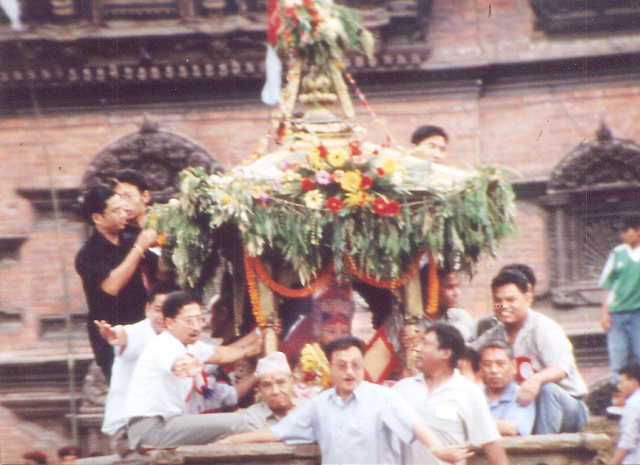 |
|
The Living Goddess
with the tiara in her head. Photo – Udyog R. Suwal
|
In Nepal, the female principle is widely and expicitly
recognized. A woman is held in high respect in Vedic religion. Shaktism (female
as a source of dynamic energy), in union with the male counterpart is
recognized as the fundamental law of creation. In Nepal and in some parts of
India, Shaktism is a popular cult and its main feature is the worship of Shakti
or Devi who is regarded as the personification of the mother goddess. The most
prominent is the worship of the living virgin goddess, Kumari.
 |
|
Nepal - Katmandu,
the entrance of the house of Kumari.
|
Kumari is a virgin, but she is also grouped as one of the
mother goddesses who are also consorts of some important male deities, like
Lord Shiva. In India, the virgin worship of Kumari dates back to more than 2600
years among the Hindus. In South India, there is a famous temple of Kanya
Kumari dedicated to the virgin goddess. Hinduism in Nepal is strongly
influenced by Buddhism and esoteric Tantrism, and the main feature of Tantrism
is the worship of Shakti. A Hindu goddess worshipped in the form of a
Buddhist girl testifies to the syncretism of religion in the Kathmandu valley.
Kumari worship or worship of virgin girls is also related with the Tantric
traditions. For attaining supernatural powers in Tantricism the virgin girls
are worshipped. Probably, the Buddhist association of Kumari originated the
Vajrayana school of Buddhism, and they got its ideas from the Shakti cult of
the Hindus. Kumari is very popularly worshipped both by Hindus and Buddhists.
 |
|
She occasionally
show herself at the window and gives darshan ( benevolent show-up ) to the
visitors.
|
These virgin Buddhist girls must be unmenstruated.
Kumari is considered to be very pure and powerful. In Kathmandu valley small
girls of age 2 to 4 are selected from the Sakya caste of Buddhist Newar
community, one of the ethnic groups of Nepal. The girls should be in good health
and should not have suffered from any serious illness, physical scar or defect
on her. She should also not have lost blood, especially due to menstruation or
loss of teeth. She should be able to walk, have black hair and eyes. She should
not have an unpleasant body odour, and she should look calm, composed and
normally unafraid. She should have all the 32 qualities of a goddess. This girl
is then worshipped as Kumari untill some signs of impurity such as loss of
teeth or beginning of her first menstruation or some incurable disease arise.
 |
|
The crowd is
waiting for the procession.
|
In Nepal there are several Kumaris. But the most
influential Kumari is the Royal Kumari of Kathmandu. Her blessings were even
sought by the King for successful governance. She could offer kingship and
extend the ruling period of a king, annually reaffirmed the mandate received by
the King to rule the kingdom. In the selection of Royal Kumari there is a very
vigorous test carried out by a committee headed by the Chief Priest of the
King. Her horoscope needs also to be read and found compatible with that of the
King. In the case of Royal Kumari, if the girl starts weeping she is
disqualified and the selection is again done for replacing her with a new one.
 |
|
The temple house of Royal Kumari was constructed in 1757,
near the old palace of Kathmandu (the white building in the photograph).
|
When a Kumari is disqualified, it is considered that the goddess has left her body. She becomes just an ordinary girl and can go to school and take part in other normal activities. As Kumari, she was not given any education, or training in reading and writing. Kumari is not allowed to put her feet on the ground, to touch any animal. Kumaris, especially Royal Kumari, live a life of imprisonment. She should not be touched other than the guardian of Kumari. An ex-Kumari can marry. However there is a belief that supernatural power remains in her as a result of which the man who marries her is destined to die soon. Ex-Kumaris are given 7 USD monthly upto 21 years old and some amount for the wedding ceremony. She is asked to return all valuble items. Valubles must be returned to a special fund that supports the Kumari. She has to adjust herself from the status of a divine being to a human being.
 |
|
The wheels of her
chariot.
|
In the recently changed political situation in Nepal, the
future of the cult of the Living Goddess has been a subject of a great deal of
discussion. Slowly several traditions are showing signs of fading out or
becoming out of place in the present situation.



Hiç yorum yok:
Yorum Gönder